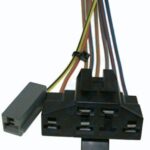Understanding your 2012 Volvo’s On-Board Diagnostics II (OBD2) protocol is crucial for effective vehicle maintenance and troubleshooting. This guide delves into the specifics of the OBD2 protocol for 2012 Volvo models, providing you with the knowledge to interpret diagnostic data and keep your car running smoothly.
OBD2 Protocol Basics: What You Need to Know
OBD2 is a standardized system implemented in most cars manufactured after 1996. Its primary function is to monitor vehicle systems, including engine, transmission, and emissions, and report any malfunctions. This system uses a standardized connector and a set of diagnostic trouble codes (DTCs) that can be accessed using a scan tool. The OBD2 protocol dictates how communication between the scan tool and the vehicle’s computer (ECU – Engine Control Unit) occurs.
For 2012 Volvo vehicles, like many modern cars, the OBD2 system is mandatory and compliant with global standards. This means you can use any generic OBD2 scanner to access basic diagnostic information. However, understanding the nuances of Volvo’s implementation can significantly enhance your diagnostic capabilities.
An OBD II connector, typically located under the dashboard of most modern vehicles.
2012 Volvo Specifics: Protocol and Implementation
While the fundamental OBD2 protocols are standardized, manufacturers like Volvo may have specific implementations or enhanced diagnostic capabilities beyond the basic requirements. For a 2012 Volvo, the OBD2 protocol will primarily utilize:
- CAN (Controller Area Network): This is the backbone of modern automotive communication. CAN is a high-speed network that allows different electronic control units (ECUs) within the vehicle to communicate with each other. OBD2 diagnostics in 2012 Volvos heavily rely on the CAN protocol for data exchange.
- ISO 15765-4 (CAN): This ISO standard, also known as Unified Diagnostic Services (UDS) over CAN, is the diagnostic protocol most likely used by a 2012 Volvo over the CAN network. It defines the format and procedures for diagnostic communication, including request and response messages for reading diagnostic data, clearing codes, and performing other diagnostic functions.
While older protocols like ISO 9141 might be mentioned in technical contexts or older documentation, for a 2012 Volvo, CAN and ISO 15765-4 are the relevant communication standards for OBD2 diagnostics.
Diagnostic Tools and Procedures for 2012 Volvo OBD2
To interact with your 2012 Volvo’s OBD2 system, you’ll need a compatible scan tool. These tools range from basic handheld code readers to advanced professional-grade diagnostic scanners.
Basic OBD2 Code Readers: These affordable tools can read and clear basic OBD2 fault codes. They are suitable for identifying common engine or emissions-related issues indicated by the “check engine light.”
Advanced Diagnostic Scanners: For more in-depth diagnostics, especially with Volvo-specific systems, you might need a more advanced scanner. These tools often offer:
- Enhanced Volvo-Specific Codes: Access to manufacturer-specific DTCs beyond the generic OBD2 codes, providing more detailed fault information.
- Live Data Streaming: Real-time monitoring of various sensor data (engine temperature, RPM, sensor readings etc.) which is invaluable for troubleshooting intermittent problems.
- Actuation Tests: The ability to activate certain vehicle components (like relays or solenoids) to test their functionality.
- Service Resets and Calibrations: Some advanced scanners can perform service functions like resetting oil life monitors or calibrating electronic systems.
Procedure for using an OBD2 Scanner:
- Locate the OBD2 Port: Typically found under the dashboard on the driver’s side.
- Connect the Scanner: Plug the OBD2 scanner into the port with the ignition turned off.
- Turn Ignition ON: Turn the ignition to the “ON” position (engine off).
- Follow Scanner Instructions: Navigate the scanner menu to connect to the vehicle and perform the desired diagnostic functions (read codes, view live data, etc.).
A mechanic utilizing an OBD2 scanner to diagnose a vehicle, highlighting the diagnostic process.
Troubleshooting Common OBD2 Issues on 2012 Volvos
While OBD2 is a robust system, communication problems can sometimes occur. Here are some potential issues and troubleshooting steps:
-
Scanner Not Connecting:
- Check Connection: Ensure the scanner is firmly plugged into the OBD2 port.
- Ignition Position: Verify the ignition is in the “ON” position.
- Scanner Compatibility: Confirm your scanner is compatible with OBD2 and CAN protocols.
- Vehicle Battery: A low vehicle battery can sometimes interfere with OBD2 communication.
- OBD2 Port Issues: Less commonly, the OBD2 port itself might be damaged or have wiring problems.
-
Incorrect or No Codes Retrieved:
- Scanner Limitations: Basic scanners may not access all Volvo-specific codes.
- Protocol Mismatch: In rare cases, there might be a communication issue due to protocol mismatch, although this is unlikely with standard OBD2 compliant tools and 2012 Volvos.
- ECU Issues: In very rare scenarios, an issue with the vehicle’s ECU itself could prevent proper diagnostic communication.
-
Interpreting Diagnostic Trouble Codes (DTCs):
- Generic vs. Volvo-Specific Codes: Generic OBD2 codes (starting with P0, P2, etc.) are standardized. Volvo-specific codes (often starting with P1, P3, or manufacturer-specific prefixes) require Volvo-specific code definitions for accurate interpretation.
- Reliable Code Definitions: Use reputable sources or your scanner’s built-in database to look up DTC definitions. Online resources and repair manuals can be helpful.
Conclusion
Understanding the 2012 Volvo Obd2 Protocol, primarily based on CAN and ISO 15765-4, empowers you to effectively diagnose and maintain your vehicle. By utilizing the right diagnostic tools and understanding the basics of OBD2 communication, you can efficiently identify issues, potentially saving time and money on car repairs. For complex problems or Volvo-specific diagnostics, consulting a qualified mechanic with Volvo diagnostic expertise is always recommended. Remember to always consult your Volvo owner’s manual and repair information for the most accurate and model-specific details.
